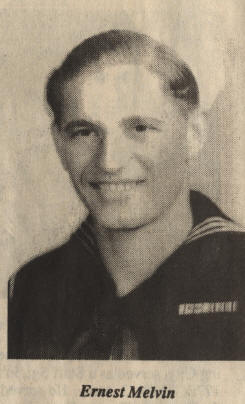![]()
 |
 |
 |
![]()
MADE UP FOR DRY RUN ON KISKA ISLAND
Melvin, who was a Seaman 1st Class with the Fifth
Amphibious Force, recalls his wartime service in a brief written recollection provided to
The Daily Journal. He now resides in
Farmington.
"I took boot training at Government Island off
Alameda, Calif., and boarded the LST 69 at Mare Island in early July. After standing many fire watches for a couple of
weeks, we departed for the Aleutian Islands with U.S. soldiers and Canadian rangers.
What had happened was that the 343rd Fighter Group and
other Allied forces who had been in the Aleutians for nearly a year had driven the
Japanese back to their last stronghold on Kiska. As
the Allies prepared for what was expected to be a bloody battle on Kiska, the Japanese
took advantage of a dense fog to pull off the island.
"It was also anticipated at the time of the
invasion that the Allied force would be engaged by the Japanese fleet - another encounter
tht did not occur.
"After spending about three months in Aleutian
waters, our flotilla of LST's and other amphibious ships departed for San Francisco and
after a brief stay in San Francisco departed for Santa Barbara, Calif., where we picked up
Seabees and transported them to Pearl Harbor for overseas duty."
Unknown to Melvin and his fellow Coast Guardsmen, they
were headed for some of the most intense Central Pacific action of the war.
"After departing Pearl Harbor our flotilla,
together with many other ships, proceeded to Pago Pago, Samoa, to pick up the reinforced
First and Second Marine Divisions who had fought at Guadalcanal. At this time we were unaware that we were heading
for the battle of Tarawa and the invasions of the Gilberts and Marshall Islands.
Melvin notes, "After participating in the battles
of Tarawa in the Gilberts and Kwajalein and Eniwetok in the Marshalls, our flotilla of
seven LST's was reduced to three ships due to enemy action.
My ship,the LST 69, was severely damaged by a near bomb miss at Kwajalein. After departing the Marshall Islands, we were
forced to proceed all the way back to Pearl Harbor and had many submarine contacts on the
way.
"Upon arriving at Pearl Harbor, we went into dry
dock and the ships were repaired and refitted with more anti-aircraft weapons. On leaving dry dock and being joined by four LST's,
we proceeded to Westloch, Pearl Harbor where we took on ammunition and Marine troops.
Melvin concludes, "After the loss of our seven
ships, the officers and men who qualified were transferred back to the States to go on
leave and stateside duty. I arrived home on
July 4, 1944 and had stateside duty until I was discharged in April of 1946."
The information on this site is provided free for the purpose of researching your genealogy. This material may be freely used by non-commercial entities, for your own research. The information contained in this site may not be copied to any other site without written "snail-mail" permission. If you wish to have a copy of a donor's material, you must have their permission. All information found on these pages is under copyright of Oklahoma Cemeteries. This is to protect any and all information donated. The original submitter or source of the information will retain their copyright. Unless otherwise stated, any donated material is given to MOGenWeb to make it available online.